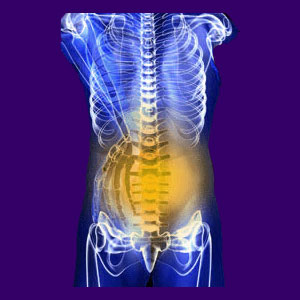
Flat back is a diagnostic term used to describe the reduction or loss of one or more of the normal spinal curves in the lumbar or thoracic spinal regions. The spinal curves are designed to bear weight and absorb shock throughout the spinal column. Reduction of one or more of these curves has long been blamed for the commencement of pain and other related symptoms. While the occurrence of pain is possible for severe cases of spinal straightening, it is rare. Most mild to moderate cases of straight spine are not the source of back ache, but instead, may actually be one of the collateral results of a pain syndrome.
This treatise details the diagnosis of a straightened spinal column in one or more regions of the backbone.
Flat Back Terminology
There are several other common names used to describe a loss of spinal curvature. Straight spine or straight back are typical and appropriate descriptions. Lordotic loss, lumbar hypolordosis, reduced lumbar lordosis or loss of lumbar lordosis are appropriate terminology for a straightening of the lower back region. Kyphotic loss, thoracic hypokyphosis, reduced thoracic kyphosis or loss of thoracic kyphosis are appropriate for straightening of the middle back region. Straight neck, military neck, loss of cervical lordosis, cervical hypolordosis or reduced cervical lordosis are all appropriate for straightening of the neck region.
As with so many other back pain related conditions, the diversity of nomenclature utilized during the diagnostic process certainly does not make things very clear for the patient. I have long spoken out for more standardized diagnostic terminologies to be used to help “tell it like it is”, instead of “telling it the way I want to, because I am the doctor”.
Flat Spine Symptoms
Nature allows for infinite variation and in the case of spinal straightening, there is no exception. Mild to moderate spinal straightening is not normally a problem and does not usually cause any pain.
Often, the condition is blamed for creating otherwise idiopathic back pain syndromes in which no better cause can be located in the spine.
Of course, some of these uncomfortable conditions are examples of psychoemotional back pain problem and the straightened spine is merely a convenient scapegoat on which to blame the symptoms. Others are the direct result of yet undiagnosed structural processes which have caused muscular spasms and the resulting loss of lordosis or kyphosis.
Severe loss of spinal curvature can indeed cause physical pain and health complications, but these circumstances are rare. In these uncommon cases, there are both conservative and drastic treatments available. Make sure to consult with your doctor to discuss all therapy options before deciding on an appropriate back pain treatment modality.
Just remember that if there is an underlying process driving muscles to enact the decreased curvature, treating the lost curves is not the right approach to care. Instead, it is necessary to find the causation of the muscular issues, resolve it and then allow the curvature to return organically.
Flat Back Factsheet
When we are discussing a hypolordotic or hypokyphotic condition, we are describing a loss of the curvature which can only be seen if you visualize the spine from the side. When viewed from the front or back, the spine will look pin-straight. However, it is actually multiply curved and is designed this way for maximum support, flexibility and durability.
Do not confuse normal or atypical front to back curvature, called lordosis or kyphosis, for an atypical side to side curvature, called scoliosis. These are 2 completely separate conditions altogether. However, it should be mentioned that they often exist at the same time in the same patient.





